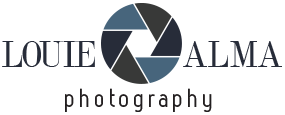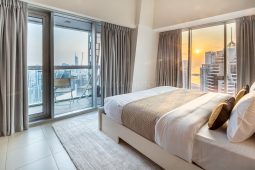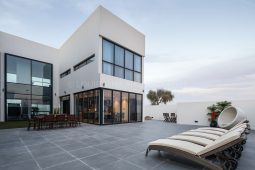Cannes, St Tropez, Marseille and Menton do the festivities very differently, so choose a resort to suit your wintry mood, and prepare to be pleasantly surprised, not just by the sunlight. “Cannes is for living, Monte Carlo for gambling and Menton for dying” was the Victorian mantra – with scene-stealing Cannes still living it up on these palm-fringed shores.
If you happen to be carefree and child-free at New Year, come for The Great Gatsby celebrations in Cannes, which promise decadence inspired by the novel penned nearby a century ago. F Scott Fitzgerald loved the Riviera, from the fast women to the hard-drinking men, and, even if the Flappers have gone, the restive, rebellious spirit remains.
Prepare to party like it’s 1925, with Coco Chanel beach pyjamas and pearls optional.
Cannes is always red-carpet ready

Lucia beachclub Cannes c Lisa Gerard-Sharp
Dressed in its winter finery, Cannes is always red-carpet ready. Lucia, the most spirited beach club on the starry Croisette, has gone as red as a lobster, its festive theme. Lobster stars on the menu and has even crawled sideways into the Christmas design concept. The club’s pink, playful, Miami-on-the- Med ambience is an antidote to traditional tinsel-town elsewhere.
I arrive to find Brighton-based designer Georgie Morley deep in decorating festive baubles with her charmingly offbeat approach. On a mission to sample all three Christmas markets in a day, I stick with spicy hot chocolate, despite tempting sightings of octopus salad and herb-incrusted cod.
Bathed in beach vibes and the winter sun, this whimsical bar-restaurant is big on fun and short on ceremony, unlike its stuffier rivals. As a year-round destination, maximalist Lucia tempts locals with its delicious Mediterranean menus and low-key events, from a Christmas run to DJs and Pilates on the beach.
New Year is celebrated with a so-called “recovery lunch,” featuring plenty of bubbles and lobster rolls with a zingy twist, much like this joyful beach club itself.
Palm Beach, Cannes’ upmarket pleasure-dome

Palm Beach in Cannes c Palm Beach
Celebrations continue at the tip of the bay, where Palm Beach, an Art Deco pleasure dome, has been reborn as Cannes’ swishest party palace. In winter, the spirit of languid, old-school glamour is enhanced by the twinkling lights of a chic new Christmas Village overlooking the bay and islands.
Under the palms, ice skaters, dancers, and Gospel Singers mingle with Champagne-sipping locals. The market is dotted with gourmet chalets, definitely not huts. Think: silky Savoyard raclette, foie gras or oysters shucked by Santa, all washed down with the finest Champagne. As a Riviera rebel, I opt for an Aperol spritz and socca, a crunchy chickpea pancake stuffed with mozzarella. Instead, the chic Cannois are queueing up to sip Champagne on the regal red-velvet Christmas throne.
This is Cannes at its most seductive, harking back to the Roaring Twenties, when Cannes was called the Los Angeles of France. Summer or winter, the city is still in thrall to the mystique of Hollywood and tends to slap a poster of George Clooney over any unsightly building works. Twinned with Beverley Hills, posy Cannes would never accept that, without the movie magic, it’s just Brighton with better weather – and Clooney as an accidental ambassador.
Luckily, the mystique is burnished at Palm Beach, where the eclectic Hispano-Moorish masterpiece exudes cinematic appeal. From the Art Deco pool to the James Bond-style casino and tempting boutiques and restaurants, Palm Beach is a magnet for the chic set. Never more so than now, when the winter revellers leave the oysters and ice rink for feasting in Palm Beach’s stylish seafront restaurants.

New Year at Zuma Cannes c RusneDraz
This pleasure-dome is home to Mediterranean cuisine in La Petite Maison, Italian classics in the Fellini-esque Il Grande, and Japanese seafood mastery in moody Zuma.
Partying Cannes at Palm Beach
Let your palate guide you to a New Year’s party, complete with a Cannes firework display. Most Palm Beach restaurants combine memorable food with a showstopping mood and musical interludes.
If you’ve had a surfeit of festive cheer, dine in chic Zuma, which is tinsel-free and, with its pure Japanese Zen spirit, mercifully lacking in Christmas cheesiness. There might be lobster on the menu, along with DJ sets and a New Year’s countdown on the seafront terrace.

Great Gatsby on the Riviera c Lisa Gerard-Sharp
Instead, New Year at Il Grande is celebrated with a decadent Great Gatsby party, a reminder that the era of Art Deco casinos,classy cabaret and time-warp piano bars was in full swing here a century ago.
Market-hopping along the Croisette
At Christmas, the Croisette, the see-and-be-seen esplanade with ideas above its station, is decorated with illuminated palms. Competing Christmas markets waylay you the length of the seafront, but the conviviality, live music and gourmet tastings should enchant the most cynical visitors.
The inviting Christmas Village at the foot of the Old Town encompasses the biggest, most central market and connects with the fabled Croisette. The Champagne ice bar lets us know we’re in chic Cannes but the craft beer stand is almost as popular. Mulled wine and hot cider compete with rum hot toddy made with honey, cinnamon and nutmeg. French regional cooking is to the fore, with fondue and smoked raclette from the Alps along with hearty sausages and sauerkraut from Alsace.
Clustered around gourmet chalets and a virtually free ice rink, the market also celebrates crafts and local designers, selling fripperies such as lanterns, silk scarves and Christmas crib figurines.
Cannes is France’s top events city and the Palais des Festivals, home to the Film Festival, is seeing in New Year with a Bollywood extravaganza. But beyond the Film Festival, the only stars are those on top of Cannes’ Christmas trees. For star-power, the giant one outside the Palais wins the Palme d’Or.
At the Carlton, Cannes’ most historic hotel, a more elitist Christmas market features an ice bar, ice rink and a cluster of gourmet chalets for Champagne and crepes, hot chocolate, panettone and waffles. Lapping up the nostalgia at Luigi Ciné Club Movie night on the fabled Croisette offers a flavour of old-school Cannes before Me-Too moved in.
Cannes, resolutely un-woke, presents herself as the coy poster girl for the Riviera good life – slightly tipsy, sophisticated and seductive, but available at the right price.
As Champagne-quaffing Cannes is big on cinematic showing off, it’s time to head to Luigi Ciné Club for an evening of old-school glamour with Lady Gaga. On winter Sundays, this decadent dinner-club turns into a retro-chic cine-club showcasing cult classics. The scene is set by the red-velvet banquettes and salted popcorn ready for the showing of “A Star is Born.”
Writer Graham Greene, who once lived on the Riviera, would have wallowed in the retro mood and the bubbles. As this former spy used to say, “Champagne, if you are seeking the truth, is better than a lie detector.” Over an intimate Champagne dinner of delicious truffled pasta and crème caramel, I mourn the end of my meal even more than I do the movie’s tragic conclusion.
St Tropez out of season
Further west, St Tropez is a place we’ve all been to, if only in our imaginations. Today’s St Tropez is partly the creation of the arty expat set, with a pleasure-seeking DNA that lures us still. The festive season is largely for the locals, which makes it even more special for visitors.
My wintry highlights are the dancing on ice shows and the spectacular sound and light displays that illuminate the facades on the port. The Christmas market stalls display crafts and cribs while serving hot chocolate and sparkling Champagne. At its simplest, the festive season is also about watching the locals play pétanque (boules). Music is ever-present, from Gospel concerts to carols, culminating in fireworks and the convivial end-of-year aperitif and anchovy feast.
The festive season is also great value, with St Tropez staging myriad free events, from horse-drawn carriage rides to concerts, ice shows, skating and cine-clubs. It’s quirky, fun, foodie, virtually all free and reveals a more authentic side of the resort, with a taste of Provencal customs and delicacies.
Multifaced Marseille defies expectations
Feisty, free-spirited Marseille bows to no one, not even Santa. While beyond the Riviera, unsung Marseille is well-connected in transport terms and presents a more authentic face of Southern France.
The Christmas markets are less polished but the conversations with the locals may be more rewarding. Unlike in Cannes, there are few pampered pooches with blonde highlights peering out of designer handbags. People-watching trumps pet-watching here. But an encounter with a grumpy fisherman shucking oysters on the quayside might just result in a tip for the best bouillabaisse, a fish stew that celebrates this gutsy city.
I hop onto the virtually free ferry and cross the Vieux Port to the Town Hall to see the official Christmas tree and portside illuminations. Clustered on the steps up to the Old Town are kitsch but cute scenes of teddy-bear adventurers enclosed in giant glass baubles. It’s all rather underwhelming.
To feel the true spirit of the season, I take the tourist train uphill to Notre Dame de la Garde, Marseille’s best-loved church. From on high, sunset bathes the forts, the Old Port, the specks of islands beyond. The basilica is also the beloved city symbol, believed to protect fishermen, sailors and pilgrims.
Spiritually restored, I return to the port for a tasty Lebanese lunch in Les Grandes Halles, a vibrant food hall spilling out onto an appealing pedestrian square. Set on Cours d’Estienne d’Orves, this is café central with a great maritime past, once a harbour, canal basin and arsenal, first for Roman galleys then for the king’s fleet. It’s now the best square for nightlife by the Old Port: the history of Marseille summed up in one square.
Nearby, laidback Louison serves the stand-out lunch of the stay, from gourmet mushroom soup to the freshest fish. Set in the delightful Hotel Amista, an engaging boutique retreat, Louison is run by an English chef steeped in creative French cuisine. The sparky staff and culinary flair will live with me long after the festive decorations are forgotten.
Menton – when life gives you lemons

Menton Xmas Market c Marine Marrec
At the Italian end of the coast, pastel-tinged Menton feels like the perfect Riviera resort. Old-fashioned and charmingly civilised, it feels languid enough to accommodate any whims. And I had whims aplenty last Christmas, when celebrating my Christmas Eve birthday without close family.
Everything went swimmingly, beginning with a massage and swim in a beachside spa and aquatic centre on Cap Martin. This was followed by a Provencal lunch of stuffed vegetables at the Xmas market and a brisk coastal walk under blazing sunshine to the Italian border, all for a cup of decent coffee. Whim satisfied, it was on to an inspection of giant cinematic scenes made from citrus fruits, a Menton art form that is perfected in the famous Lemon Festival in February.

Roquebrune Xmas c Lisa Gerard-Sharp
Instead, Christmas Day meant a foray to Roquebrune, a gorgeous medieval hilltop village in the hinterland. La Grotte de l’Olivier, the randomly chosen restaurant, was scenically set at the foot of a ruined 10th-century castle close to an ancient olive tree. To cap it all, Santa on a donkey came winding through medieval alleys to greet me at the restaurant. The Provencal lunch culminated in Limoncello made with Menton lemons and a commitment to spending more self-indulgent birthdays abroad.
From Menton to Marseille, the Riviera has Christmas wrapped. The festive season on the Med is delectably different, with freshly shucked seafood on the quayside and Santa arriving by sea at St Tropez. Fancy oysters by an ice rink in Cannes? A cine-club by the beach? Too much Limoncello and Champagne in Menton? As Scott Fitzgerald said, “Too much of anything is bad but too much Champagne is just right.” Gatsby lives on.
The Festive Riviera: How to do it
- In Cannes, Palm Beach is about style and retro glamour, so splash out in Zuma and Il Grande and La Petite Maison.
- Lucia Cannes offers Riviera charm, American energy, creative cocktails and inventive spins on Mediterranean food.
- Luigi is a jazzy piano bar and intimate supper club that becomes Luigi Ciné Club on Sunday evenings in winter for Italian-style movie nights.
- In Marseille, Amista is a central, charmingly individualistic boutique hotel. Louison, Amista’s restaurant is open to all and serves fantastic, good-value, creative food.
- Les Grandes Halles is a vibrant all-day food hall near the Old Port.
- La Grotte de l’Olivier, Roquebrune Village for New Year’s lunch
More info:
St Tropez, St Tropez tourism
Festive programme and events Golfe Saint Tropez
Marseille tourism is helpful and friendly.
Menton tourism is helpful and covers the villages too
Lisa Gerard-Sharp is an award-winning travel journalist who lives between the French Riviera, London and Italy.
The post How to have a quirky Christmas on the Cote d’azur, France appeared first on The Travel Magazine.











